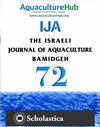Assembling the superior biofloc tilapia strains for industry
IF 0.5
4区 农林科学
Q4 FISHERIES
引用次数: 0
Abstract
The decreasing productivity and increasing environmental pressure on intensive tilapia culture in open waters, especially in floating net cages, have forced the development of a biofloc system for tilapia farming. This study aimed to develop the superior tilapia strain suitable for the biofloc system and to observe their productivity and economic profitability under commercial scale in the biofloc system. The selective breeding activity was carried out on 100 families reared and mated in hapa (a double-walled contrivance in which an inner hapa, made of mosquito netting material, is installed within an outer one made of whole cloth) in the biofloc pond for three generations. The individual selection was conducted at the age of 6 months on the characters of standard length and body weight with the best 10% of the top part of the population as a reference for the formation of the next generation. After three generations, the offspring obtained from mass spawning were grown out in round-limen ponds and square-concrete ponds for productivity and profitability observations. The results showed that heritability values of the biofloc tilapia strain were 0.4196 (standard length, SL) and 0.4898 (body weight, BW). The average response selection of BW and SL was 13.04% and 6.11%, respectively. Biomass gain was obtained between 19.29–28.83 kg/m3. The production multiply value was 8.07-13.59x. The average daily weight growth was between 2.8g-3.0g. The Benefit-Cost ratio is valued from 1.81 to 2.71. The superior tilapia biofloc strain has a moderate heritability value. When it is raised in a biofloc ponds system at different volumes, it significantly affects the productivity on biomass, body weight, and multiplication value. Also, it is advantageous when applied on an industrial scale.为工业组装优质罗非鱼生物群落品系
在开放水域,特别是在浮动网箱中集约化养殖罗非鱼的生产力下降和环境压力增加,迫使罗非鱼养殖生物絮群系统的发展。本研究旨在培育适合该生物絮团系统的优质罗非鱼品系,并观察其在商业规模下的生产效率和经济效益。在生物群落池中用hapa(一种双层装置,内hapa由蚊帐材料制成,外hapa由全布制成)饲养和交配的100个家庭进行了三代的选择性育种活动。在6月龄时对标准体长和体重性状进行个体选择,以种群顶部最优的10%作为下一代形成的参考。三代后,在圆形石灰池和方形混凝土池中培养大量产卵的后代,观察其生产力和盈利能力。结果表明,该生物群落罗非鱼品系的遗传力分别为0.4196(标准长度,SL)和0.4898(体重,BW)。BW和SL的平均响应选择率分别为13.04%和6.11%。生物量增重在19.29 ~ 28.83 kg/m3之间。生产倍数为8.07-13.59倍。平均日增重在2.8g-3.0g之间。收益成本比在1.81到2.71之间。优越的罗非鱼生物群落品系具有中等的遗传力值。在不同体积的生物絮团池塘系统中饲养,对生物量、体重和繁殖值的生产力有显著影响。此外,当应用于工业规模时,它是有利的。
本文章由计算机程序翻译,如有差异,请以英文原文为准。
求助全文
约1分钟内获得全文
求助全文
来源期刊
CiteScore
0.90
自引率
16.70%
发文量
49
审稿时长
3 months
期刊介绍:
Information not localized

 求助内容:
求助内容: 应助结果提醒方式:
应助结果提醒方式:


